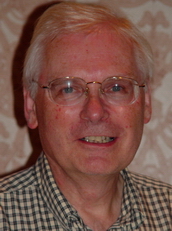

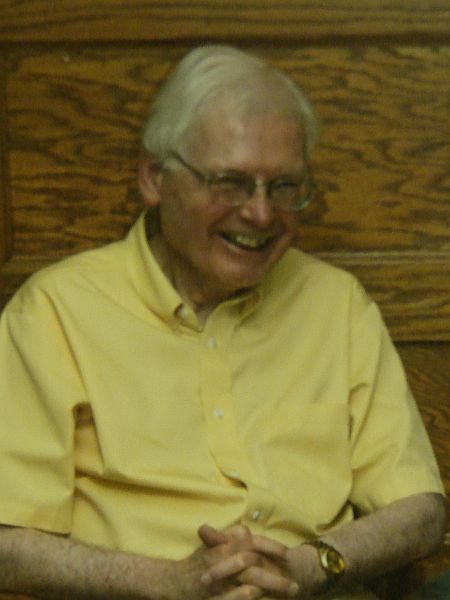
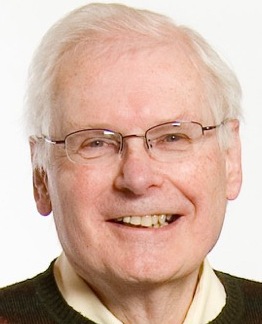
Lynn Arthur Steen (St. Olaf College, Northfield, MN, USA) has edited or co-edited five booklets on quantitative literacy (QL). These booklets helped define QL as the use of mathematical and logical thinking in context.
Lynn Steen (pictured above) is arguably the father of the Quantitative Literacy (numeracy) movement while Richard Schaeffer and Linda Sons are the god parents.
Lynn Steen (1941-2015) Biography Obituary Schield eulogy MAA Obituary St. Olaf Obituary Star-Tribune Obituary
The need for Quantitative Literacy (QL) is generally accepted. But the content and teaching of QL is under active discussion and debate. The quotes from the following publications present some of that discussion.
While four of the six booklets shown here are edited by Lynn Arthur Steen and two more are co-edited by Bernard Madison and Lynn Steen, they all contain ideas presented by many people. In the Steen-Madison books, Robert Orrill (to name just one) worked tirelessly in support of QL as have the members of the Mathematics and Democracy Design team and the members of the National Numeracy Steering Committee. [Note: this US National Numeracy effort is different from the National Numeracy Strategy in the UK.]. [While the following are all quotes from the listed publications, this page has not been reviewed or approved by any of those mentioned on this page.]
For more on Quantitative Literacy, see the MAA webpage.
General Comments on Numeracy and QL:
- Numeracy takes years of study and experience to achieve.
- An innumerate citizen today is as vulnerable as the illiterate peasant of Gutenberg's time.
- In the twenty-first century, literacy and numeracy will become inseparable qualities of an educated person.
- It is time for a change, time to recognize the unique quantitative requirements of universal education in the computer age.
- The essence of QL is to use mathematical and logical thinking in context.
Leadership in Undergraduate Mathematics Education: An Example by Joel Cunningham, Sewanee: The U of the South.
Abstract: “Lynn Arthur Steen, Professor Emeritus of Mathematics at St. Olaf College and former President of the Mathematical Association of America, is recognized widely for the extraordinarily valuable leadership he has given in undergraduate mathematics education, at his college, nationally, and internationally. This article outlines some of his remarkable contributions, shares some of his thinking about his experience, and includes a few further reflections.” Journal of Mathematics Education at Teachers Colleges Vol 4: Spring-Summer 2013, P 34-39.
- “No one has led more effectively than Lynn Steen in the development of undergraduate mathematics during our lifetime.” David Broussoud.
Articles on Quantitative Literacy by Lynn Steen
Citations of Steen's QL articles as of March 2017. ## indicates booklet listed below
- 2011 “ Reflections on the 10th Anniversary of Mathematics and Democracy” (with Bernard L. Madison). Numeracy, 4:1 (January 2011).
- 2009 “Adrift in a Sea of Numbers.” Honors Day Convocation, St. Olaf College, May 1, 2009.
- 2009 Confronting Challenges, Overcoming Obstacles: A Conversation about Quantitative Literacy (with B. Madison). Numeracy 2:1 (Jan)
- 2008 ## Booklet Calculation vs. Context: Quantitative Literacy and Its Implications for Teacher Education. (Co-editor: B. Madison) See below.
- 2008 Reflections on Wingspread Workshop by Lynn Steen. P 11-23 in Calculation vs. Context: QL and Its Implications for Teacher Education
- 2008 Evolution of Numeracy and the National Numeracy Network by Steen and Madison. Numeracy. 2008 Vol 1, Issue 1. P.1–18.
- 2008 “The National Numeracy Network: A Brief History” (with B. Madison). Numeracy: Advancing Education in Quantitative Literacy, 1:1 (Jan)
- 2005 Asking the Right Question by Lynn Steen. Focus Nov P. 41–48.
- 2004 Everything I Needed to Know about Averages ... I Learned in College by Lynn Steen. AAC&U Peer Review, 6:4 (Summer 2004) pp. 4–8.
- *2004 Achieving Quantitative Literacy: An Urgent Challenge for Higher Education. MAA 2004. $34 MAA Bookstore
- 2003 ## Booklet Quantitative Literacy: Why Numeracy Matters for Schools and Colleges, editor (with B. Madison). See below.
- 2003 Review of Damned Lies and Statistics, by Joel Best. Notices of the American Mathematical Society, 50:2 (February 2003) 228–231.
- 2002 Reading, Writing and Numeracy by Lynn Steen.
- Quantitative Literacy: Why Numeracy Matters for Schools and Colleges. Focus, 22:2 (February 2002) 8–9. [PDF Version.]
- 2001 Quantitative Literacy: A World Awash in Numbers. Education Week, 21 (September 2001) 58. [PDF Version.]
- 2001 Mathematics and Numeracy: Two Literacies, One Language The Mathematics Educator, Jrnl Singapore Assoc.Math Educators 6:1-10-16
- 2001 The Case for Quantitative Literacy by Lynn Steen. P 1-22. Mathematics and Democracy: The Case for Quantitative Literacy. NCED
- 2001 Epilogue: Embracing Numeracy by Lynn Steen. P.107-115. Mathematics and Democracy: The Case for Quantitative Literacy. NCED
- 2000 Mathematics, Numeracy, and Statistics Proceedings of the 2000 AMESA National Congress, pp. 367–372.
- 2000 Reading, Writing, and Numeracy, by Lynn Steen in Liberal Education, 86:2 (Spring 2000) pp. 26–37. [Alternate Version.]
- 1999 Bibliography of Quantitative Literacy Compiled by Lynn Steen.
- 1999 Numeracy: The New Literacy for a Data-Drenched Society, Educational Leadership, 57:2 (October 1999), pp. 8–13.
- 1999 Beyond 8th Grade: Functional Mathematics for Life and Work by Susan Forman & Lynn Steen. Nat Center for Research Vocational Educ.
- 1997 The New Literacy by Lynn Steen. Opening chapter in Why Numbers Count: QL for Tomorrow's America. The College Board, pp. xv–xxviii.
- 1997 ## Booklet. Why Numbers Count: Quantitative Literacy for Tomorrow's America (Lynn Steen). The College Entrance Exam Board, 1997.
- 1995 “Reckoning vs. Reasoning: A Struggle for the Soul of Mathematics” (with Susan L. Forman). The Condition of American Liberal Education, Robert Orrill, Editor. The College Board, 1995, pp. 259-264.
- 1992 ## Booklet Heeding the Call for Change. Edited by Lynn Steen MAA. [Entire book. See below]
- 1990 Numeracy. Daedalus, 119:2 (Spring 1990) 211-231.
- 1990 ## Booklet On the Shoulders of Giants: New Approaches to Numeracy. National Academy Press.
Calculation vs. Context: Quantitative Literacy and Its Implications for Teacher Education (2008) Local PDF
Editors: Bernard L. Madison and Lynn Arthur Steen
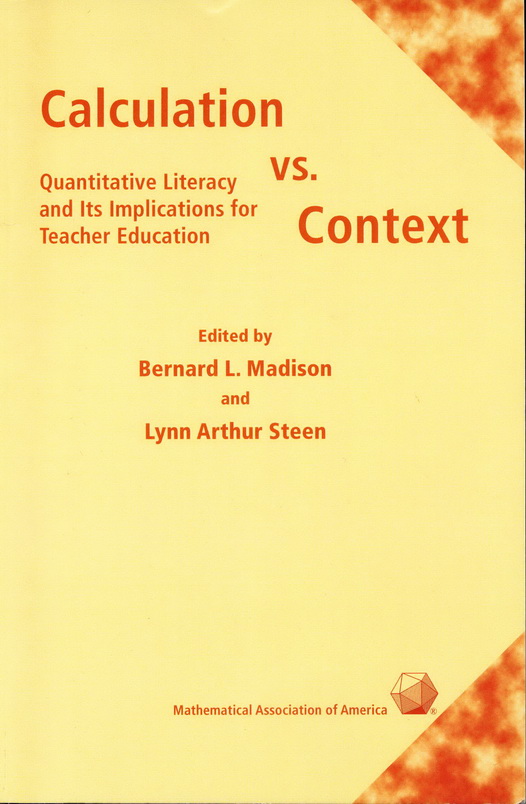 “Innovative and more effective quantitative literacy
education is urgent both as a part of revitalization of liberal education
and as a response to the increasing quantitative reasoning demands of US
society. In the information age of today and tomorrow, lives are
increasingly governed by numbers. The ubiquity of data and analyses of data
require one to use sound quantitative reasoning to cope intelligently with
the requirements of citizenship, job and family, and to be prepared for a
healthy, happy and productive life. But quantitative reasoning for the
practical circumstances of life is not part of the school or college
curriculum — even for those taking a large complement of mathematics and
science courses. In particular, it is not part of the college education of
prospective teachers, and it is not a major part of the current national
agenda reshaping school curricula. Achieving a quantitatively literate
citizenry requires serious changes in the education of teachers and the
curricula they teach. Thus, the need for a conference on Quantitative
Literacy and Its Implications for Teacher Education.”
— From the letter of invitation to conference participants
“Innovative and more effective quantitative literacy
education is urgent both as a part of revitalization of liberal education
and as a response to the increasing quantitative reasoning demands of US
society. In the information age of today and tomorrow, lives are
increasingly governed by numbers. The ubiquity of data and analyses of data
require one to use sound quantitative reasoning to cope intelligently with
the requirements of citizenship, job and family, and to be prepared for a
healthy, happy and productive life. But quantitative reasoning for the
practical circumstances of life is not part of the school or college
curriculum — even for those taking a large complement of mathematics and
science courses. In particular, it is not part of the college education of
prospective teachers, and it is not a major part of the current national
agenda reshaping school curricula. Achieving a quantitatively literate
citizenry requires serious changes in the education of teachers and the
curricula they teach. Thus, the need for a conference on Quantitative
Literacy and Its Implications for Teacher Education.”
— From the letter of invitation to conference participants
“Innovative and more effective quantitative literacy education is urgent both as a part of revitalization of liberal education and as a response to the increasing quantitative reasoning demands of US society. Thus, the need for a conference on Quantitative Literacy and Its Implications for Teacher Education.” MAA Bookstore.
“This volume contains the broadest interpretation yet of quantitative literacy (QL) as it should play out across the school and college curriculum. Nine commissioned essays on QL and teacher education by scholars in eight academic disciplines both challenge and expand more traditional views of QL. These essays, introductions by editors Bernard Madison and Lynn Steen, and brief summaries of discussions summarize the proceedings of a June 2007 multi-disciplinary conference held at Wingspread Conference Center and sponsored by the MAA's NSF-funded PMET project.” — MAA 2008 Fall/Winter Catalog
Conference Steering Committee: Stanley Katz, Princeton University; Bernard L. Madison, University of Arkansas; Robert Orrill, National Council on Education and the Disciplines; Richard Scheaffer, University of Florida; Carol Geary Schneider, Association of American Colleges and Universities; Lynn Arthur Steen, St. Olaf College; Corrine Taylor, Wellesley College; Alan Tucker, State University of New York at Stony Brook
PDF 2008. PDF 2009
Table of Contents
INTRODUCTION:
Planning a Conversation about Quantitative Literacy and Teacher Education, Bernard L. Madison
Reflections on Wingspread Workshop, Lynn Arthur Steen.
Keynote Presentation:
Reflections on Quantitative Reasoning: An Assessment Perspective, Richard J. Shavelson
- “The teaching of mathematics K–16 ... has not met the challenge of creating a quantitatively literacy citizenry.”
Commissioned Papers:
Humanism and Quantitative Literacy, Robert Orrill “Humanists seem always to have kept a worried eye on quantification.”
- “Opposition to quantification has become deeply-seated in the heritage of humanism.”
Arguing with Numbers: Teaching QR through Argument and Writing, Neil Lutsky
- “Mathematicians are least-well prepared to deal with the meaning of socially-constructed numbers, which is the essence of QL.”
Fractions and Units in Everyday Life, Alan Tucker
Quantitative Literacy and School Mathematics: Percentages and Fractions, Milo Schield
- “[To improve algebra,] introduce rates and percentages as presented in tables and graphs in middle school as a pre-Algebra bridging course,”
- [As an alternative to Algebra II], introduce a Quantitative Literacy course or a Statistical Literacy course.
Preparing Students for the Business of the Real (and Highly Quantitative) World, Corrine Taylor
Beyond Calculation: Quantitative Literacy and Critical Thinking about Public Issues, Joel Best
- “the cause of quantitative literacy faces two challenges:
- first recognizing that Q/L must encompass more than matters of calculation, and
- second, finding ways to integrate Q/L — and critical thinking more generally — into the curriculum.”
Quantitative Literacy for All: How Can We Make it Happen, Hugh Burkhardt “If QL is not taught in Mathematics, it will not happen.”
The Licensure of Teachers for Quantitative Literacy: Who Should Be Entitled to Teach QL?, Frank B. Murray
- “Lasting change begins with a clear conception of the measurable features of numeracy.”
Achieving Quantitative Literacy (2004) MAA or Amazon
An Urgent Challenge for Higher Education (edited by Lynn Arthur Steen) MAA review
 Literacy includes “prose, document and quantitative literacy.”
Literacy includes “prose, document and quantitative literacy.”
“Document literacy refers to reading charts and tables.” p. xi.
“Quantitative literacy refers to interpreting and reasoning with numbers.” p. xi
“The essence of QL is to use mathematical and logical thinking in context.” p.47
QL skills involve “sophisticated reasoning with elementary mathematics rather than elementary reasoning with sophisticated mathematics.” p. 9
“Because of their education and training, most teachers are not prepared for or comfortable with the mathematics required for quantitative literacy.” p.47
“According to Johnny Lott, former president of NCTM, it is simply unrealistic to expect that teachers of other subjects will either know or understand what might be considered quantitative literacy.” p. 47
“QL advocates need to be very clear about what all students need to know and be able to do, starting with where it fits into the mathematics program.” Janice Somerville, p.3.
Earlier innovative, QL-type courses “had one thing in common that contributed to their remaining a small elective rather than a major requirement — they were designed specifically to focus on ideas — generally QL-like ideas — rather than techniques. This made them more difficult for teachers to teach and for students to master, and for that reason they thrived only in special niches out of the mainstream of college mathematics.” p. 39
“Thus, on both sides of the school-college boundary, policy related to quantitative literacy is inextricably tied with mathematics and statistics.” p. 33
“In reality, data analysis — what most statisticians actually practice — is typically more than the average person needs to be an informed citizen, intelligent consumer or skilled worker. What everyone needs is typically called statistical thinking or statistical literacy, a crucial component of quantitative literacy.” p. 43
“Although most adults see probabilistic and statistical arguments every day, few have any preparation to make sense out of them.” Deborah Hughes Hallet, p. 43
Not withstanding the importance of quantitative literacy to health, politics, work and personal finance, in our discipline-dominated education system, QL has neither an academic home nor an administrative promoter.” p. xi
“Although mathematics certainly cannot bear the sole burden of quantitative literacy, it is the discipline best suited to play a leadership role.” p.44
“It may well be that with regard to our democratic conception of higher education, it is undergraduate mathematics that is most out of date.” p. 5
“It is time for a change, time to recognize the unique quantitative requirements of universal education in the computer age.” p.9
Reviewed in The American Statistician (2006) V 1. “Many of the problems that are cited as reasons why typical citizens need to be quantitatively literate are in fact subtle and difficult. A good example mentioned in the book is that of false positives in screening for cancers. Can a QL curriculum be expected to emphasize basic skills also introduce such tough cases? And how can we measure whether the students are essentially literate? It is in the development of tools for the assessment of quantitative skills that statisticians have some experience and perhaps can offer assistance in solving this problem.”
Reviewed in the MAA online by Charlotte Chell: “The great accomplishment of Achieving Quantitative Literacy is that it articulates the urgent need with an eloquent philosophy of education and democracy, and a vision that is both compelling and awesome; yet it never forgets that the real-world mathematical/QL problems to be solved are everyday tasks that will often be contextually messy. As the Responses to the Findings demonstrate, the real-world implementation of QL education will also require everyday tasks that are not always elegant, and not always comfortable for mathematicians.”
Quantitative Literacy: Peer Review 2004
Everything I learned about Numbers..., I learned in College by Lynn Arthur Steen
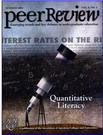 “QL is anchored in context; the objects of QL are data.”
“QL is anchored in context; the objects of QL are data.”
“Quantitative reasoning relies on concepts first introduced in middle school — averages, percentages, graphs.”
“Averages, like percentages, are also a source of mysteries.”
“my point is that QL is sufficiently sophisticated to warrant inclusion in college study and, more important, that without it students cannot intelligently achieve major goals of college education.”
“Quantitative literacy is not just a set of precollege skills. It is as important, as complex, and as fundamental as the more traditional branches of mathematics.”
“One clear priority has emerged: the need to develop benchmarks for quantitative literacy that can guide both curriculum and assessment in grades 10–16.”
Other Related Publications
- Quantitative Literacy: Why Numeracy Matters for Schools and Colleges Conference review. Focus, 2/2002 (MAA Online 2004)
- Numeracy: The new Literacy for a Data Drenched Society 10/1999 Educational Leadership
Quantitative Literacy
Why Numeracy Matters
for Schools and Colleges (2003)
MAA
or
Amazon
Edited by Bernard L. Madison and Lynn Arthur Steen
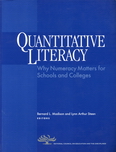 “Quantitative literacy, in my view, means knowing how to reason and how to
think and it is all but absent from our curricula today.”
Users of quantitative information “have to learn how to think
for themselves, and that is what an education in quantitative
reasoning can teach them.” Gina Kolata (1997)
“Quantitative literacy, in my view, means knowing how to reason and how to
think and it is all but absent from our curricula today.”
Users of quantitative information “have to learn how to think
for themselves, and that is what an education in quantitative
reasoning can teach them.” Gina Kolata (1997)
“The attention to quantitative reasoning that she [Gina Kolata, see above] thinks so essential to sound judgment simply does not exist in the academic programs of most of our schools and colleges.” Robert Orrill
“To expand the conversation about QL, the NCED subsequently sponsored a national forum, Quantitative Literacy: Why Numeracy Matters for Schools and Colleges, held at the National Academy of Sciences in Washington D.C. on December 1–2, 2001. This volume represents the proceedings of this Forum and includes papers commissioned as background for that Forum, essays presented at that Forum, and selected reactions to that Forum.” Bernard Madison
“Numeracy lies at the intersection of statistics, mathematics and democracy. Like statistics, numeracy is centered on interpretation of data; like mathematics, numeracy builds on arithmetic and logic. But the unique niche filled by numeracy is to support citizens in making decisions informed by evidence.” “Numeracy is largely an approach to thinking about issues that employs and enhances both statistics (the science of data) and mathematics (the science of patterns). Yet unlike statistics, which is primarily about uncertainty, numeracy is often about the logic of certainty. And unlike mathematics, which is primarily about the Platonic realm of abstract structures, numeracy often is anchored in data derived from and attached to the empirical world.” Lynn Steen, p. 62–63.
“Quantitative Literacy (QL), the ability to use numbers and data analysis in everyday life, is everybody's orphan. Despite every person's need for QL, in the discipline-dominated K-16 education system in the United States, there is neither an academic home nor an administrative promoter for this critical competency.” p. 153 Bernard Madison
“In reality, full-bore data analysis is more than most people need to deal with the statistical issues of everyday life and work.” P. 146 “Many statisticians would probably disagree with the statement in Mathematics and Democracy that QL is ‘not the same as statistics.’ Indeed many think that a very large part of QL is statistics...” p.147 “Those experienced with teaching statistics suggest that one way to garner administrative support [for QL across the curriculum] and foster institutional change is to tie much of QL to the statistics curriculum, everywhere it is housed.” p.149 “Statistics and quantitative literacy have much in common. Although few would disagree with this, statisticians would probably argue that QL is mainly statistics while mathematicians and mathematics educators tend to argue that QL is only partly statistics.” p. 151 Richard Scheaffer
“Statistical methods are about logic as well as numbers. For this reason, as well as on account of their pervasiveness in modern life, statistics cannot be the business of statisticians alone, but should enter into the schooling of every educated person. To achieve this would be a worthy goal for statistics in the coming decades.” Porter, 2001
“many aspects of statistical thinking are not about numbers as much as about concepts and habits of mind. For example, the idea of a lurking variable upsetting an apparent bivariate relationship with observational data is a conceptual idea, part of statistical thinking, but not particularly about numbers.” p. 150 Richard Scheaffer.
Entire document:
TABLE OF CONTENTS:
Background Papers:
- Introduction: The Many faces of Quantitative Literacy, Bernard Madison.
- Need for Work and Learning: The Many Faces of Quantitative Literacy, Bernard Madison; Democracy and the Numerate Citizen, Patricia Cohen; The Democratization of Mathematics, Carnaevale and Desrochers; What Mathematics should “Everyone” Know and Be Able to Do, Arnold Packer; Quantitative Literacy in the Workplace, Linda Rosen.
- Curriculum Issues: Data, Shapes, Symbols: Achieving Balance in School Mathematics, Lynn Steen; Mathematics for Literacy, Jan de Lange; The Role of Mathematics Courses in the Development of Quantitative Literacy, Deborah Hughes-Hallett; The Third R in Literacy, Richardson and McCallum.
- Policy Challenges: Articulation and Mathematical Literacy: Political and Policy Issues, Michael Kirst; “Get Real!” Assessing for Quantitative Literacy, Grant Wiggins; Statistics and Quantitative Literacy, Richard Scheaffer; Articulation and Quantitative Literacy, Bernard Madison.
Forum Papers:
- Need for Work and Learning: Addressing Societal and Workforce Needs, David Brakke; Making Mathematics Meaningful, Arnold Packer; Grounding Mathematics in Quantitative Literacy, Johnny Lott; Quantitative Literacy: A Science Literacy Perspective, George Nelson; Learning and Work in Context, William Steenken; Of the Teachers, by the Teachers and for the Teachers, Roger Howe; Impediments to and Potentials for Quantitative Literacy, J. T. Sutcliffe.
- Policy Perspectives: Say What you Mean (and Mean What You Say), Janis Somerville; Education Policy and Decision Making, Margaret Cozzens; Policies on Placement and Proficiency Tests: A Community College's Role, Sadie Bragg; Standards are Not Enough: Challenges of Urban Education, Judith Rizzo; Creating Networks as a Vehicle for Change, Susan Ganter.
- International Perspectives: Numeracy in an International Context, Lynn Steen; Quantitative Literacy and Mathematical Competencies, Morgan Niss; Defining Mathematical Literacy in France, Michel Merle; What Mathematics for All?, A. Geoffrey Howson; Numeracy: A Challenge for Adult Education, Mieke van Groenestijn; The Role of Mathematics in Building a Democratic Society, Ubiratan D'Ambrosio.
- Reflection Papers: Why Are We Here?, Jeanne Narum; Quantitative Literacy Goals: Are We Making Progress?, Rita Colwell; What Have We Learned… and Have Yet to Learn?, Hyman Bass; Reflections from several forum participants.
Mathematics and Democracy
The Case for Quantitative Literacy (2001) Edited by Lynn Steen MAA or PDF MAA review
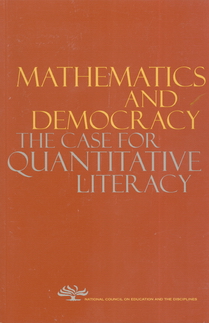 “Despite its occasional use as a euphemism for statistics in school
curricula, quantitative literacy is not the same as statistics. Neither
is it the same as mathematics, nor is it (as some fear) watered-down
mathematics. Quantitative literacy is more a habit of mind, an
approach to problems that employs and enhances both statistics and
mathematics. Unlike statistics, which is primarily about uncertainty,
numeracy is often about the logic of certainty. Unlike mathematics,
which is primarily about a Platonic realm of abstract structures,
numeracy is often anchored in data derived from and attached to the
empirical world. Surprisingly to some, this inextricable link to reality
makes quantitative reasoning every bit as challenging and rigorous as
mathematical reasoning.”
“Despite its occasional use as a euphemism for statistics in school
curricula, quantitative literacy is not the same as statistics. Neither
is it the same as mathematics, nor is it (as some fear) watered-down
mathematics. Quantitative literacy is more a habit of mind, an
approach to problems that employs and enhances both statistics and
mathematics. Unlike statistics, which is primarily about uncertainty,
numeracy is often about the logic of certainty. Unlike mathematics,
which is primarily about a Platonic realm of abstract structures,
numeracy is often anchored in data derived from and attached to the
empirical world. Surprisingly to some, this inextricable link to reality
makes quantitative reasoning every bit as challenging and rigorous as
mathematical reasoning.”
“In the twenty-first century, literacy and numeracy will become inseparable qualities of an educated person.”
“Numeracy takes years of study and experience to achieve.”
“Although quantitative literacy is a recent and still uncommon addition to the curriculum, its roots in data give it staying power.”
“Numeracy will thrive similarly because it is the natural tool for comprehending information in the computer age.”
“Numeracy embodies the capacity to communicate in this new language.”
“colleges seem to have no clear vision about the goals of quantitative literacy or the means by which these goals can most readily be achieved.”
“Numeracy is not the same as mathematics, nor is it an alternative to mathematics.”
MAA Online Book Review of Mathematics and Democracy
Mathematics and Democracy: The Case for Quantitative Literacy PDF (Lynn Steen, editor). National Council on Education & the Disciplines
Chapters:
- The Case for Quantitative Literacy by Lynn Steen. P 1–22.
- Epilogue: Embracing Numeracy by Lynn Steen P.107–115.
Why Numbers Count
Quantitative Literacy for Tomorrow's America (1997) Edited by Lynn Steen College Entrance Exam Board
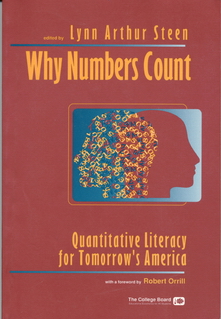 “Numeracy is the new literacy of our age.”
“Numeracy is the new literacy of our age.”
“The relentless quantification of society continues unabated.”
“In short an innumerate citizen today is as vulnerable as the illiterate peasant of Gutenberg's time.”
“The ascendancy of quantitative information has changed profoundly not only the environment in which we live and work, but also the entire framework of civic life.”
“The tendency to reduce complex information to a few numbers is overwhelming — in health care, in social policy, in political analysis, in education. ... Although the widespread availability of data should enrich public discourse, inevitable over-simplifications and misinterpretations may ultimately cheapen it. ... Instead of enhancing Jeffersonian democracy, limited numeracy can easily shift the balance to a technocracy.”
“Innumeracy thus becomes another means of disenfranchisement: by reinforcing the idea that truth is relative and unknowable, people with the least defenses against charlatans will be most vulnerable.”
CONTENTS:
- Numeracy and Quantitative Literacy (Table of Contents)
- Why Numbers Count: Foreword by Robert Orrill
- The New Literacy (PDF) by Lynn Steen
- Defining Quantitative Literacy
- The Triumph of Numbers: Civic Implications of Quantitative Literacy by Theodore Porter. “Rarely do they [students] learn what a stratified sample is, or how an unemployment rate is determined, or what the smog index measures. The sorts of numbers that modern citizens are likely to confront in their lives as citizens and voters have little place in the modern curriculum.”
- Civic Numeracy: Does the Public Care? by Deborah Wadsworth
- Making Mathematics The Great Equalizer by Shirley Malcom (AAAS)
- Numeracy: Imperative of a Forgotten Goal by Iddo Gal
- Thinking Quantitatively about Science by James Rutherford (AAAS)
- Mere Literacy is not Enough by George Cobb
- Solving Problems in the Real World by James Pollak
- Quantitative Practices by Peter J. Denning
- Organizing Mathematics Education around Work by Gary Hoachlander
QUANTITATIVE REASONING FOR COLLEGE GRADUATES. CUPM.
HEADING THE CALL FOR CHANGE Edited by Lynn Steen. MAA 1992.
Standing on the Shoulders of Giants: New Approaches to Numeracy. Edited by Lynn Steen. National Academy Press, 1990.
Abstract: Forces created by the proliferation of computer hardware and software, by innovative methods of mathematical modelling and applications, by broader demographic considerations, and by schools themselves, are profoundly changing the way mathematics is practiced, the way mathematics is taught, and the way mathematics is learned. In this volume, a vision of the richness of mathematics is expressed and illustrated as five different possible strands of school mathematics through the expansion on the theme of mathematics as the language and science of patterns with emphases on interconnections and communalit1es. Included are: (1) an introduction to the five sample strands with examples of the continuity underlying the fundamentals of mathematics, of the mathematical connections that both unite and rapeat[?], and of the mathematical perspective necessary to view both the variety and the regularity of patterns, (2) the Dimension strand, which focuses on the development of relationships between the different dimensions with emphasis on three-dimensional topics; (3) the Quantity strand, which provides insights into the three basic tasks of measuring;, ordering, and coding with attendant symbologies and procedures1 (4) the Uncertainty strand, which develops ideas about the natural themes and strategies within the twin concepts of data and chance; (5) the Shape strand, which uses classification to discover similarities and differences among objects, analysis to discern the components of form, and representation to recognize and comprehend shapes within different contexts; and {6)vthe Change strand, which advocates imaginative and sensitive responses to the constantly emerging new types of patterns, including patterns of thinking about nature, as well as mathematics. (31 references) (JJK)
CONTENTS:
- Preface (Lynn Steen)
- Pattern (Lynn Steen)
- Dimension (Thomas Banchoff)
- Quantity (James Few)
- Uncertanty (David Moore)
- Shape (Majorie Senechal)
- Change (Ian Stwwart)
- Biographies and Index
Numeracy-Related Items
1998 CUPM-MAA First 40 Years of Recommendations
CUPM Panel on Statistics: For non-Statisticians (1972) For Statisticians (1971)
Lynn Steen's Mathematically-based articles and publications
- 2007 Developing Mathematical Literacy (with R. Turner and H. Burkhardt). In Modeling and Applications in Mathematics Education. pp 285–294.
- 2007 How Mathematics Counts by Lynn Steen. Educational Leadership Assoc. for Supervision & Curriculum Development (ASCD). Nov. p. 9–14
- 2007 On Being a Mathematical Citizen: The Natural NExT Step by Lynn Steen. The Ninth James R. C. Leitzel Lecture MAA San Jose CA.
- 2007 Facing Facts: Achieving Balance in High School Mathematics by Lynn Steen. The Mathematics Teacher Vol 100. P 86–95.
- 2002 Growing Math Majors at St. Olaf by Lynn Steen. The Educational Trust. Summer 2002.
- 2002 Achieving Mathematical Proficiency for All: Moving Beyond the Math Wars by Lynn Steen. College Board Review, 196 (Spring 2002) 4–11.
- 2001 Twenty Questions about Pre-Calculus Keynote by Lynn Steen at “Rethinking the Preparation for Calculus” Conference. P. 8–12.
- 2000 Analysis 2000: Challenges and Opportunities by Lynn Steen. p. 193–210.
- 2000 Review of A Mathematical Mystery Tour by A. K. Dewdney. Reviewed by Lynn Steen in Notices of the AMS Vol 47, N2. P 221–224.
- 1999 Twenty Questions about Mathematics by Lynn Steen. Concluding chapter in 1999 NCTM Yearbook. P. 270–285.
- 1998 Reflections on Mathematical Patterns, Relationships, and Functions by Lynn Steen. Minn. K–12 Mathematics Framework, SciMath-MN
- 1998 CUPM Recommendations: The First 40 Years Introduction by Lynn Steen. MAA. [Entire document]
- 1997 The New Literacy. Opening chapter in Why Numbers don't Count.
- 1992 Does Everybody Need to Study Algebra? Mathematics Teacher. [Copy of original]
- 1991 “Foreword” to Math Panic by Laurie Buxton. Heinemann Educational Books, 1991.
- 1991 Reaching for Science Literacy. Change, 23:4 (July–Aug. 1991) 10–19. [PDF Original.]
- 1990 Mathematical News That's Fit to Print. The Popularization of Mathematics, Howson & Kahane ed. Cambridge U. Press, pp. 176–193.
- 1988 Mathematics: The Science of Patterns by Lynn Steen. Science Vol 240. 29 April, 1988. P 611–616.
- 1988 Mathematics for a New Century by Lynn Steen. ICME-VI, Budapest, July 27 – Aug. 4, 1988.
- 1988 Celebrating Mathematics by Lynn Steen. The American Mathematical Monthly. Vol. 95, No. 5 (May, 1988), pp. 414–427.
- 1987 Calculus for a New Century: A Pump, Not a Filter Edited by Lynn Steen. National Research Council.
- 1987 Mathematics Education: A Predictor of Scientific Competitiveness by Lynn Steen. Science Vol 237. Policy Forum 17 July p 251–252, 302
- 1986 Twenty Questions for Calculus Reformers by Lynn Steen. Presented at Tulane University.
- 1986 Mathematics: Our Invisible Culture Lynn Steen. Opening address at a symposium on science and the liberal arts at Dickinson College.
- 1985 A 'Minds-On' World. Focus, March–April 1985, p. 4.
- 1984 “1 + 1 = 0: New Math for a New Age” (editorial) Science, 225 (7 Sep. 1984) 981; [Excerpt. The Washington Post, (4 Sep. 1984) A18.]
- 1978 Math is a Four Letter Word. The Mathematical Intelligencer, 1 (1978) 171–172.
- 1975 Foundations of Mathematics: Unsolvable Problems. Science New Series, Vol. 189, No. 4198 (Jul. 18, 1975), pp. 209–210

